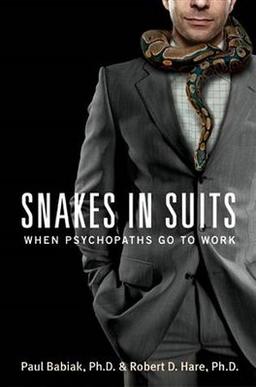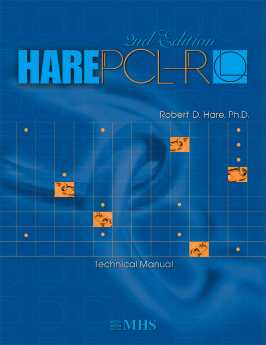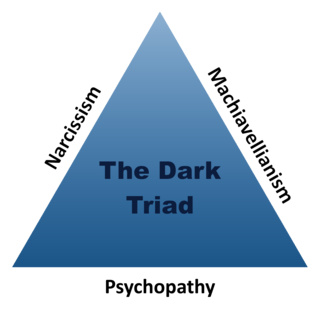Related Research Articles
Antisocial personality disorder is a personality disorder characterized by a limited capacity for empathy and a long-term pattern of disregard or violation of the rights of others. Other notable symptoms include impulsivity and reckless behavior, a lack of remorse after hurting others, deceitfulness, irresponsibility, and aggressive behavior.

Hervey Milton Cleckley was an American psychiatrist and pioneer in the field of psychopathy. His book, The Mask of Sanity, originally published in 1941 and revised in new editions until the 1980s, provided the most influential clinical description of psychopathy in the twentieth century. The term "mask of sanity" derived from Cleckley's belief that a psychopath can appear normal and even engaging, but that the "mask" conceals a mental disorder. By the time of his death, Cleckley was better remembered for a vivid case study of a female patient, published as a book in 1956 and turned into a movie, The Three Faces of Eve, in 1957. His report of the case (re)popularized in America the controversial diagnosis of multiple personality disorder. The concept of psychopathy continues to be influential through forming parts of the diagnosis of antisocial personality disorder, the Psychopathy Checklist, and public perception.
Theodore Millon was an American psychologist known for his work on personality disorders. He founded the Journal of Personality Disorders and was the inaugural president of the International Society for the Study of Personality Disorders. In 2008 he was awarded the Gold Medal Award For Life Achievement in the Application of Psychology by the American Psychiatric Association and the American Psychological Foundation named the "Theodore Millon Award in Personality Psychology" after him. Millon developed the Millon Clinical Multiaxial Inventory, worked on the diagnostic criteria for passive-aggressive personality disorder, worked on editions of the Diagnostic and Statistical Manual of Mental Disorders, and developed subtypes of a variety of personality disorders.
Malignant narcissism is a psychological syndrome comprising an extreme mix of narcissism, antisocial behavior, aggression, and sadism. Grandiose, and always ready to raise hostility levels, the malignant narcissist undermines families and organizations in which they are involved, and dehumanizes the people with whom they associate.

Snakes in Suits: When Psychopaths Go to Work is a 2006 non-fiction book by industrial psychologist Paul Babiak and criminal psychologist Robert D. Hare. The book describes how a workplace psychopath can take power in a business using manipulation.
Psychopathy is a mental health condition characterized by persistent antisocial behavior, impaired empathy and remorse, and bold, disinhibited, and egotistical traits. Different conceptions of psychopathy have been used throughout history that are only partly overlapping and may sometimes be contradictory.

The Psychopathy Checklist or Hare Psychopathy Checklist-Revised, now the Psychopathy Checklist—revised (PCL-R), is a psychological assessment tool that is commonly used to assess the presence and extent of the personality trait psychopathy in individuals—most often those institutionalized in the criminal justice system—and to differentiate those high in this trait from those with antisocial personality disorder, a related diagnosable disorder. It is a 20-item inventory of perceived personality traits and recorded behaviors, intended to be completed on the basis of a semi-structured interview along with a review of "collateral information" such as official records. The psychopath tends to display a constellation or combination of high narcissistic, borderline, and antisocial personality disorder traits, which includes superficial charm, charisma/attractiveness, sexual seductiveness and promiscuity, affective instability, suicidality, lack of empathy, feelings of emptiness, self-harm, and splitting. In addition, sadistic and paranoid traits are usually also present.

The Mask of Sanity: An Attempt to Clarify Some Issues About the So-Called Psychopathic Personality is a book written by American psychiatrist Hervey M. Cleckley, first published in 1941, describing Cleckley's clinical interviews with patients in a locked institution. The text is considered to be a seminal work and the most influential clinical description of psychopathy in the twentieth century. The basic elements of psychopathy outlined by Cleckley are still relevant today. The title refers to the normal "mask" that conceals the mental disorder of the psychopathic person in Cleckley's conceptualization.
Fictional portrayals of psychopaths, or sociopaths, are some of the most notorious in film and literature but may only vaguely or partly relate to the concept of psychopathy, which is itself used with varying definitions by mental health professionals, criminologists and others. The character may be identified as a diagnosed/assessed psychopath or sociopath within the fictional work itself, or by its creator when discussing their intentions with the work, which might be distinguished from opinions of audiences or critics based only on a character appearing to show traits or behaviors associated with an undefined popular stereotype of psychopathy.

The dark triad is a psychological theory of personality, first published by Delroy L. Paulhus and Kevin M. Williams in 2002, that describes three notably offensive, but non-pathological personality types: Machiavellianism, sub-clinical narcissism, and sub-clinical psychopathy. Each of these personality types is called dark because each is considered to contain malevolent qualities.
The low arousal theory is a psychological theory explaining that people with attention deficit hyperactivity disorder (ADHD) and antisocial personality disorder seek self-stimulation by excessive activity in order to transcend their state of abnormally low arousal. This low arousal results in the inability or difficulty to sustain attention on any task of waning stimulation or novelty, as well as explaining compulsive hyperactive behavior.

The Psychopath Test: A Journey Through the Madness Industry is a 2011 book written by British author Jon Ronson in which he explores the concept of psychopathy, along with the broader mental health "industry" including mental health professionals and the mass media. It spent the whole of 2012 on United Kingdom bestseller lists and ten weeks on The New York Times Best Seller list.
The Psychopathic Personality Inventory (PPI-Revised) is a personality test for traits associated with psychopathy in adults. The PPI was developed by Scott Lilienfeld and Brian Andrews to assess these traits in non-criminal populations, though it is still used in clinical populations as well. In contrast to other psychopathy measures, such as the Hare Psychopathy Checklist (PCL), the PPI is a self-report scale, rather than interview-based, assessment. It is intended to comprehensively index psychopathic personality traits without assuming particular links to anti-social or criminal behaviors. It also includes measures to detect impression management or careless responding.
The Levenson Self-Report Psychopathy scale (LSRP) is a 26-item, 4-point Likert scale, self-report inventory to measure primary and secondary psychopathy in non-institutionalised populations. It was developed in 1995 by Michael R. Levenson, Kent A. Kiehl and Cory M. Fitzpatrick. The scale was created for the purpose of conducting a psychological study examining antisocial disposition among a sample of 487 undergraduate students attending psychology classes at the University of California, Davis.
Callous-unemotional traits (CU) are distinguished by a persistent pattern of behavior that reflects a disregard for others, and also a lack of empathy and generally deficient affect. The interplay between genetic and environmental risk factors may play a role in the expression of these traits as a conduct disorder (CD). While originally conceived as a means of measuring the affective features of psychopathy in children, measures of CU have been validated in university samples and adults.
Psychopathy, from psych and pathy, was coined by German psychiatrists in the 19th century and originally just meant what would today be called mental disorder, the study of which is still known as psychopathology. By the turn of the century 'psychopathic inferiority' referred to the type of mental disorder that might now be termed personality disorder, along with a wide variety of other conditions now otherwise classified. Through the early 20th century this and other terms such as 'constitutional (inborn) psychopaths' or 'psychopathic personalities', were used very broadly to cover anyone who violated legal or moral expectations or was considered inherently socially undesirable in some way.
George Everett Partridge was an American psychologist credited with popularizing the term sociopath in 1930 that Karl Brinbaum had suggested in 1909. He worked with the influential G. Stanley Hall at Clark University. One year after his death, the George Everett Partridge Memorial Foundation was incorporated in 1954 by the Partridge family to memorialize his life's work in the study and treatment of mental and personality disorders. The Foundation focused on developing programs to promote treatment centers for mentally disabled children, often referred to as the "forgotten children." Partridge schools were established. The first of which was in Herndon, Virginia, for older boys with moderate mental retardation resulting from brain damage. However, the foundation was forfeited in 1991.
While psychopaths typically represent a very small percentage of workplace staff, the presence of psychopathy in the workplace, especially within senior management, can do enormous damage. Indeed, psychopaths are usually most present at higher levels of corporate structure, and their actions often cause a ripple effect throughout an organization, setting the tone for an entire corporate culture. Examples of detrimental effects include increased bullying, conflict, stress, staff turnover, absenteeism, and reduction in both productivity and social responsibility. Ethical standards of entire organisations can be badly damaged if a corporate psychopath is in charge. A 2017 UK study found that companies with leaders who show "psychopathic characteristics" destroy shareholder value, tending to have poor future returns on equity.

Quantum Night is a 2016 science-fiction thriller novel written by Canadian novelist Robert J. Sawyer. Set in 2020, the book touches on themes of quantum physics, psychology, current politics and ethics.
The influence of childhood trauma on the development of psychopathy in adulthood remains an active research question. According to Hervey M. Cleckley, a psychopathic person is someone who is able to imitate a normal functioning person, while masking or concealing their lack of internal personality structure. This results in an internal disorder with recurrent deliberate and detrimental conduct. Despite presenting themselves as serious, bright, and charming, psychopathic people are unable to experience true emotions. Robert Hare's two factor model and Christopher Patrick's triarchic model have both been developed to better understand psychopathology; however, whether the root cause is primarily environmental or primarily genetic is still in question.
References
- ↑ Edwards, Jim (November 24, 2016). "'The Hare Psychopathy Checklist': The test that will tell you if someone is a sociopath". Business Insider . Retrieved February 28, 2018.
- ↑ "Turns out, the predominant traits of psychopaths differ between cultures". The Economic Times . February 13, 2018. Retrieved February 18, 2018.
- 1 2 3 4 5 Egan, Danielle (June 12, 2016). "Into the Mind of a Psychopath". Discover Magazine . Retrieved February 28, 2018.
- 1 2 3 4 Researchers: Hare - Area: Abnormal - Affiliation: University of British Columbia The Great Canadian Psychology Website, Joint initiative of Canadian Universities, 2005-2008
- ↑ Robert Hare: Early Experience Katherine Ramsland
- ↑ "Dr. Robert Hare - Biography". www.psych.ualberta.ca. Retrieved 2019-12-15.
- ↑ Awards - R.D. Hare Lifetime Achievement Award Society for the Scientific Study of Psychopathy
- ↑ "Cheryl Hare (obituary)". The Vancouver Sun . Retrieved February 28, 2018.
- ↑ "Cheryl Wynne Hare Award - Society for the Scientific Study of Psychopathy". www.psychopathysociety.org. Retrieved February 28, 2018.
- ↑ Awards - Cheryl Wynne Hare Award Society for the Scientific Study of Psychopathy
- ↑ "CPA Donald O. Hebb Award for Distinguished Contributions to Psychology as a Science". Canadian Psychological Association. 2019. Retrieved 2019-12-14.
- ↑ General. "Mr. Robert D. Hare". The Governor General of Canada. Retrieved 2019-12-15.
- ↑ Patrick, Christopher J., ed. (2005). Handbook of Psychopathy. New York City: Guilford Press. p. 39. ISBN 978-1606238042.
- ↑ Babiak, Paul; Hare, Robert D. (2006). Snakes in Suits: When Psychopaths Go to Work. New York City: Regan Books. p. 19. ISBN 978-0-06-083-772-3.
- ↑ Spiegel, Alix (May 27, 2011). "Creator Of Psychopathy Test Worries About Its Use". NPR .
- ↑ Martens, Willem HJ (June 2008). "The problem with Robert Hare's psychopathy checklist: incorrect conclusions, high risk of misuse, and lack of reliability". Medicine and Law. International Center for Health, Law and Medicine. 27 (2): 449–62. PMID 18693491.
- ↑ Fersch, Ellsworth Lapham, ed. (2006). "What are the differences between the psychopathy definitions designed by Hare and by Cleckley?". Thinking about Psychopaths and Psychopathy: Answers to Frequently Asked Questions. Bloomington, Indiana. ISBN 9780595858910.
- ↑ Blackburn, Ronald (2005). "Psychopathy as a Personality Construct". In Strack, Stephen (ed.). Handbook of Personology and Psychopathology. Hoboken, New Jersey: John Wiley & Sons. pp. 271–289. ISBN 978-0471693123.
- ↑ Hare, Robert D.; Neumann, Craig S. (2008). "Psychopathy as a Clinical and Empirical Construct" (PDF). Annual Review of Clinical Psychology . Palo Alto, California: Annual Reviews. 4: 217–46. doi:10.1146/annurev.clinpsy.3.022806.091452. PMID 18370617.
- ↑ Tucker, Douglas; Matto, Mikel (June 1, 2014). "Measuring the Quiet Man: Estimating Risk of Violence". Psych Central Professional. Retrieved February 28, 2018.
- ↑ Murrie, Daniel C.; Cornel, Dewey G. (December 2002). "Psychopathy Screening of Incarcerated Juveniles: A Comparison of Measures". Psychological Assessment . Washington, D.C.: American Psychological Association. 14 (4): 390–396. CiteSeerX 10.1.1.177.1113 . doi:10.1037/1040-3590.14.4.390. PMID 12501564.
- ↑ Hill-Tout, Joanna (14 January 2004). "The Psychopaths in Suits". BBC .
- ↑ Carey, Benedict (June 11, 2010). "Academic Battle Delays Publication by 3 Years". The New York Times . New York City.
- ↑ Walters, Glenn D. (April 2004). "The Trouble with Psychopathy as a General Theory of Crime". International Journal of Offender Therapy and Comparative Criminology . Thousand Oaks, California: SAGE Publications. 48 (2): 133–148. doi:10.1177/0306624X03259472. PMID 15070462. S2CID 40939723.
- ↑ Hare, Robert D. (January 1, 1994). "This Charming Psychopath". Psychology Today . New York City: Sussex Publishers . Retrieved February 28, 2018.
- ↑ Perring, Christian (April 25, 1999). "Review - Without Conscience: The Disturbing World of the Psychopaths Among Us". Metapsychology Online. New York City: Guilford Press.
- ↑ Without conscience: the disturbing world of the psychopaths among us Robert D. Hare, 1 Nov 1993
- ↑ The Corporation Transcripts and Extras Archived 2013-06-01 at the Wayback Machine - Hear more from... Hare.
- ↑ Hare & Babiak, p. 95
- ↑ Ronson, Jon (2011). The Psychopath Test: A Journey Through the Madness Industry. New York City: Macmillan. ISBN 978-1447202509.
- ↑ Hare, Robert D. (April 16, 2012). "A Commentary on Ronson's The Psychopath Test: A Journey Through the Madness Industry" (PDF). www.psychopathysociety.org. Vancouver, British Columbia, Canada: Society for the Scientific Study of Psychopathy.
- ↑ Appel, Jacob M. (2017). Mask of Sanity. Sag Harbor, New York City: Permanent Press. ISBN 978-1-57962-495-8.